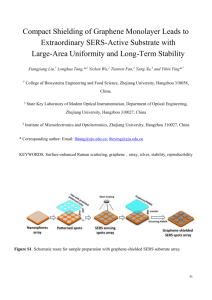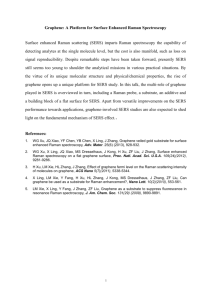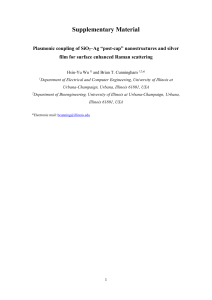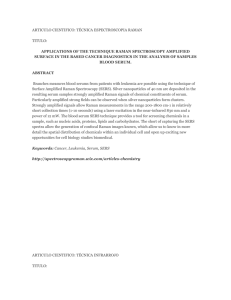Surface-enhanced Raman scattering of 3
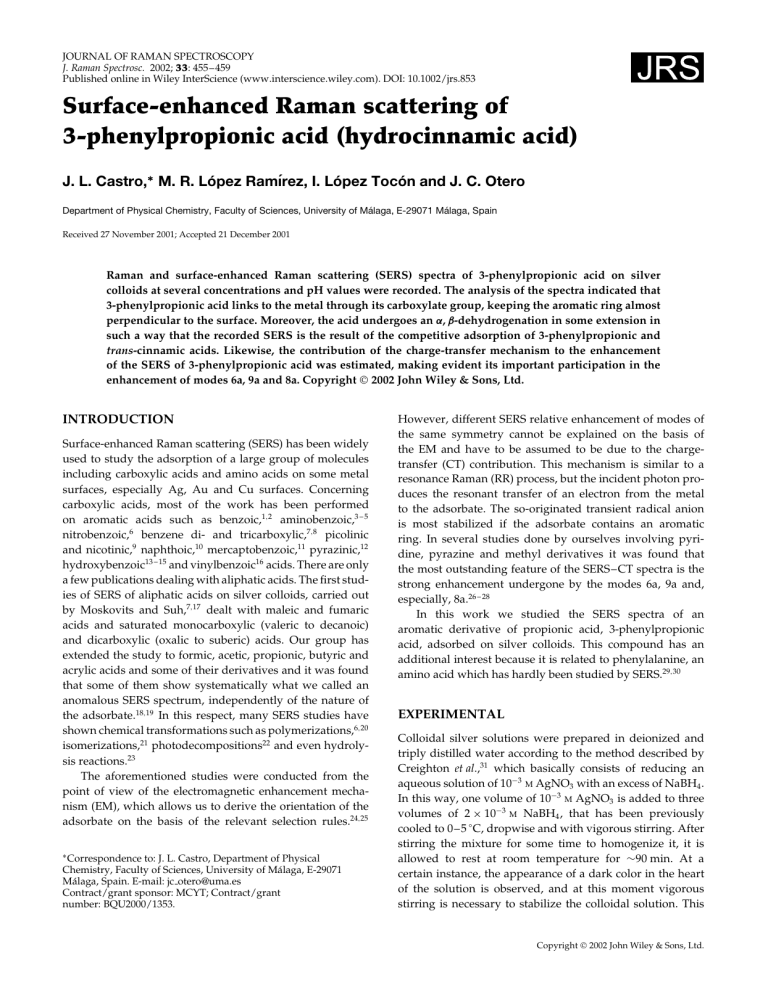
JOURNAL OF RAMAN SPECTROSCOPY
J. Raman Spectrosc.
2002; 33 : 455–459
Published online in Wiley InterScience (www.interscience.wiley.com). DOI: 10.1002/jrs.853
Surface-enhanced Raman scattering of
3-phenylpropionic acid (hydrocinnamic acid)
J. L. Castro,
∗
M. R. L ´opez Ram´ırez, I. L ´opez Toc ´on and J. C. Otero
Department of Physical Chemistry, Faculty of Sciences, University of M ´alaga, E-29071 M ´alaga, Spain
Received 27 November 2001; Accepted 21 December 2001
Raman and surface-enhanced Raman scattering (SERS) spectra of 3-phenylpropionic acid on silver colloids at several concentrations and pH values were recorded. The analysis of the spectra indicated that
3-phenylpropionic acid links to the metal through its carboxylate group, keeping the aromatic ring almost perpendicular to the surface. Moreover, the acid undergoes an a , b -dehydrogenation in some extension in such a way that the recorded SERS is the result of the competitive adsorption of 3-phenylpropionic and trans -cinnamic acids. Likewise, the contribution of the charge-transfer mechanism to the enhancement of the SERS of 3-phenylpropionic acid was estimated, making evident its important participation in the enhancement of modes 6a, 9a and 8a. Copyright
2002 John Wiley & Sons, Ltd.
INTRODUCTION
Surface-enhanced Raman scattering (SERS) has been widely used to study the adsorption of a large group of molecules including carboxylic acids and amino acids on some metal surfaces, especially Ag, Au and Cu surfaces. Concerning carboxylic acids, most of the work has been performed on aromatic acids such as benzoic, 1 , 2 aminobenzoic, 3 – 5 nitrobenzoic, 6 and nicotinic, 9 benzene di- and tricarboxylic, naphthoic, 10 mercaptobenzoic, 11
7 , 8 picolinic pyrazinic, 12 hydroxybenzoic 13 – 15 and vinylbenzoic 16 acids. There are only a few publications dealing with aliphatic acids. The first studies of SERS of aliphatic acids on silver colloids, carried out by Moskovits and Suh, 7 , 17 dealt with maleic and fumaric acids and saturated monocarboxylic (valeric to decanoic) and dicarboxylic (oxalic to suberic) acids. Our group has extended the study to formic, acetic, propionic, butyric and acrylic acids and some of their derivatives and it was found that some of them show systematically what we called an anomalous SERS spectrum, independently of the nature of the adsorbate.
18 , 19 In this respect, many SERS studies have shown chemical transformations such as polymerizations, 6 , 20 isomerizations, 21 photodecompositions 22 and even hydrolysis reactions.
23
The aforementioned studies were conducted from the point of view of the electromagnetic enhancement mechanism (EM), which allows us to derive the orientation of the adsorbate on the basis of the relevant selection rules.
24 , 25
Ł Correspondence to: J. L. Castro, Department of Physical
Chemistry, Faculty of Sciences, University of M´alaga, E-29071
M´alaga, Spain. E-mail: jc otero@uma.es
Contract/grant sponsor: MCYT; Contract/grant number: BQU2000/1353.
However, different SERS relative enhancement of modes of the same symmetry cannot be explained on the basis of the EM and have to be assumed to be due to the chargetransfer (CT) contribution. This mechanism is similar to a resonance Raman (RR) process, but the incident photon produces the resonant transfer of an electron from the metal to the adsorbate. The so-originated transient radical anion is most stabilized if the adsorbate contains an aromatic ring. In several studies done by ourselves involving pyridine, pyrazine and methyl derivatives it was found that the most outstanding feature of the SERS–CT spectra is the strong enhancement undergone by the modes 6a, 9a and, especially, 8a.
26 – 28
In this work we studied the SERS spectra of an aromatic derivative of propionic acid, 3-phenylpropionic acid, adsorbed on silver colloids. This compound has an additional interest because it is related to phenylalanine, an amino acid which has hardly been studied by SERS.
29 , 30
EXPERIMENTAL
Colloidal silver solutions were prepared in deionized and triply distilled water according to the method described by
Creighton et al ., 31 which basically consists of reducing an aqueous solution of 10 3
M AgNO
3 with an excess of NaBH
4
.
In this way, one volume of 10 3
M
AgNO
3 is added to three volumes of 2 ð 10 3
M
NaBH
4
, that has been previously cooled to 0–5 ° C, dropwise and with vigorous stirring. After stirring the mixture for some time to homogenize it, it is allowed to rest at room temperature for ¾ 90 min. At a certain instance, the appearance of a dark color in the heart of the solution is observed, and at this moment vigorous stirring is necessary to stabilize the colloidal solution. This
Copyright
2002 John Wiley & Sons, Ltd.
456 J. L. Castro et al .
is a transparent, yellow solution, with a maximum in its absorption spectrum at 390 nm. Adsorbate is then added to the colloid as an aqueous solution in order to obtain the desired concentration. A change in the color of the system, from the initial yellowish to a final blue–greenish, is observed when the adsorbate is added to the colloid.
Raman spectra were recorded with a Jobin-Yvon U-1000 double monochromator spectrometer fitted with a cooled
Hamamatsu R943-02 photomultiplier, with excitation using
514.5 nm radiation from a Spectra-Physics Model 2020 argon ion gas laser. A constant slit width was used that allowed a spectral resolution of 4 cm 1 ; the laser power reaching the sample was always 60 mW. In the case of liquid samples, a quartz cell with a 1 cm pathlength was used, whilst a glass capillary was used for microcrystalline solids. The band wavenumbers were measured with the help of the same laser plasma lines as wavenumber standards, whereby a precision of š 2 cm 1 was obtained under the operating conditions employed.
RESULTS AND DISCUSSION
Figure 1 shows the Raman spectra of 3-phenylpropionic acid in (a) the solid state and (b) a 1 M aqueous solution of its sodium salt, and (c) the SERS spectrum of a 5 ð 10 4
M aqueous solution of the acid on silver colloid at pH ¾ 5. The
SERS spectrum in Fig. 1(c) is characterized by a set of strong or medium bands recorded at 1638, 1604, 1406, 1252, 1003, 945 and 314 cm 1 . On this basis it is not straightforward to decide whether the adsorbed species is the acid or the anion, given that the mentioned bands and even some others of lower intensity can be correlated with either bands in the Raman spectrum of the acid [Fig. 1(a)] or in that of the ion [Fig. 1(b)].
However, on taking into account that the wavenumbers in the SERS recorded at pH ¾ 5 remain constant even when pH is increased up to 11, we have to conclude that the adsorbed species must be the 3-phenylpropionate ion, as expected from the value of p K a
D 4 .
66 .
32
The very strong SERS band recorded at 1638 cm interesting. It should be assigned to the vibration
1 is as
(OCO), 17 but that assignment has to be discarded because either that vibration is always recorded very weakly or it is not seen at all in the SERS spectra of many previously studied aliphatic and aromatic acids. Likewise, the experimental pH does not allow us to assign it to (C O) of the acid given that it must be red shifted by the adsorption process. Moreover, this vibration has never been assigned to any band recorded in the SERS of a carboxylic acid. Consequently, there is the possibility of a chemical transformation either catalyzed by the rough surface of the metal or photoinduced as detected in previous cases.
18 Provided that the intensity and wavenumber of the band recorded at 1638 cm 1 are characteristic of a
(C C) vibration of ˛, ˇ -unsaturated carboxylic acids, it seems sensible to suppose that 3-phenylpropionic acid has
Figure 1.
Raman spectra of (a) 3-phenylpropionic acid in the solid state and (b) 1
M aqueous solution of its sodium salt at pH
¾ 14; (c) SERS spectrum on silver colloid of a 5 ð 10 4
M solution of 3-phenylpropionic acid at pH ¾ 5.
Figure 2.
(a) Raman spectrum of a 1
M aqueous solution of sodium trans -cinnamate at pH ¾ 14; (b) SERS spectrum on silver colloid of a 5 ð 10 4
M solution of trans -cinnamic acid at pH ¾ 6.
Copyright
2002 John Wiley & Sons, Ltd.
J. Raman Spectrosc.
2002; 33 : 455–459
undergone a partial dehydrogenation to yield cinnamic acid,
PhCH CHCOOH.
In order to check that hypothesis, the Raman spectrum of an aqueous solution of sodium trans -cinnamate and the SERS spectrum of trans -cinnamic acid were recorded [Fig. 2(a) and (b)]. The two strongest bands in both spectra recorded at 1644 and 1638 cm 1 , respectively, are assigned to the
(C C) vibration, the same as in the spectrum in Fig. 1(c). It is evident also that all the SERS bands of cinnamic acid were recorded in the spectrum in Fig. 1(c). Therefore, the results indicate that the SERS spectrum in Fig. 1(c) originates from the competitive adsorption of 3-phenylpropionate and trans cinnamate ions. It must be stressed that the band recorded at
1638 cm 1 is due exclusively to the adsorbed trans -cinnamate ion but many other recorded bands contain unresolved contributions from both ions, because monosubstituted derivatives of benzene have ring vibrations with very close wavenumbers. However, the contribution of cinnamate to the remaining SERS bands should be very weak except in the bands at 1604, 1252 and 1003 cm 1 .
On the other hand, it is also interesting that ˛ phenylalanine does not undergo any chemical transformation similar to that of 3-phenylpropionic acid, which agrees with the known fact that the NH
2 group increases the stability of amino acids.
33
Figure 3 shows the SERS spectrum of 3-phenylpropionic acid obtained by subtracting the spectrum in Fig. 2(b) from that in Fig. 1(c), once the baseline correction has been done and the intensity of the band at 1638 cm 1 has been normalized in both records. Table 1 summarizes the wavenumbers of the strongest bands of the Raman spectra of 3-phenylpropionic acid and its salt, and also those of its SERS spectrum once that of cinnamate has been subtracted. Empirical assignments were made on the basis of the work by Vars´anyi 34 and Roeges 35 and vibrational studies on related molecules, namely toluene, 36 , 37 zyl chloride, 38 ethylbenzene, 39 ben-
1-chloro-2-phenylethane, 40 butanoic acid and sodium butanoate.
41 Table 2 summarizes
Figure 3.
SERS spectrum of 3-phenylpropionic acid obtained by subtracting the spectrum in Fig. 2(b) from that in Fig. 1(c).
SERS of 3-phenylpropionic acid 457 the wavenumbers of the Raman bands of trans -cinnamate ion and SERS bands of trans -cinnamic acid and also the assignments proposed on the basis of previous studies carried out on trans -cinnamic acid 42 and methyl trans -cinnamate.
43
The SERS bands of 3-phenylpropionic assigned to benzene ring vibrations, such as those recorded at 3068
(2), 1604 (8a), 1582 (8b), 1160 (9b), 1031 (18a), 1003 (12) and
622 cm 1 (6b), exhibit more or less the same wavenumbers and shape as the respective Raman bands. This means that the aromatic ring remains almost unperturbed by the adsorption.
44
The broad and strong band at 1406 cm shoulders at 1382 and 1418 cm
1 shows two
1 ; the former is assigned to the vibration s
(OCO), which shows a very characteristic group frequency in the SERS of carboxylic acids.
41 peak at 1406 cm 1 and the shoulder at 1418 cm 1
The are assigned to υ (CH
2
) vibrations by direct correlation with the Raman spectra of the acid and its salt. The enhancement and wavenumber shift undergone by s
(OCO) proves that the molecule is adsorbed through its carboxylate group.
Likewise, the band at 945 cm 1 assigned to (C–COO) is also noticeably enhanced.
Table 1.
Wavenumbers (cm
1
) of the Raman and SERS bands of 3-phenylpropionic acid and proposed assignments
Acid (solid) Salt (1 M aq. soln.) SERS Assignment a
1207
1186
1162
1035
1005
930
758
624
566
340
3060
2936
1648
1608
1588
1494
1458
1414
1377
1279
3066
2938
1606
1588
1502
1454
1412
1412
1340
1255
1207
1188
1162
1033
1005
949
776
624
566
343
3068 2; (CH)
2928 s
CH
2
(C O)
1604 8a; ring
1582 8b; ring
1498 19a; ring
1452 19b; ring
1418 υ CH
2
1406 υ CH
2
1382 s
OCO
CO C υ OH
1343 w(CH
2
)
CO C υ OH
1252 tw(CH
2
)
1207 13; (CX)
1182 9a; υ (CH)
1160 9b; υ (CH)
1031 18a; υ (CH)
1003 12; υ ring
945 (C–COO)
770 1; ring
622 6b; υ ring
572 6a; υ ring
314 υ (CCC), υ (CX)?
213 (Ag–adsorbate) a S: , Stretching; υ , in-plane bending; , out-of-plane bending; tw, twisting; w, wagging; r, rocking.
Copyright
2002 John Wiley & Sons, Ltd.
J. Raman Spectrosc.
2002; 33 : 455–459
458 J. L. Castro et al .
Table 2.
Wavenumbers (cm 1 ) of the Raman and
SERS bands of trans -cinnamic acid and proposed assignments
Salt (1
M aq. soln.) SERS Assignment a
3074
3030
1644
1604
1582
1500
1454
1394
1297
1255
1207
1184
1032
1003
981
730
?
620
3066
3004
1638
1602
1580
1500
1454
1390
1293
1254
1207
1182
1031
1002
982
768
730
?
618 a S: , Stretching; υ , in-plane bending; , out-of-plane bending; tw, twisting; w, wagging; r, rocking.
2; (CH)
(CH)
(C C)
8a; ring
8b; ring
19a; ring
19b; ring s
OCO
3; υ (CH)
υ (CH)
13; υ (CX)
9a; υ (CH)
18a; υ (CH)
12; υ ring
17a; (CH)
11; (CH)
υ (OCO)
6a; υ ring
6b; υ ring
It should be stressed that the most enhanced ring modes in the SERS spectrum of 3-phenylpropionic acid, namely
8a, 13, 9a, 18a, 12 and 6a, are totally symmetric, i.e. are
A
1 vibrations under C
2 v symmetry; furthermore, 2 ;(CH) is recorded with noticeable intensity at 3068 cm 1 . Out-ofplane vibrations are either very weak or not observed at all.
According to the EM selection rules, the aromatic ring should be oriented perpendicular to the metal surface.
On the other hand, the intensity of the bands assigned to s
CH
2
, υ CH
2 and tw CH
2
, recorded at 2928, 1406 and
1252 cm 1 , respectively, indicates that one of the methylene groups is close to the metal surface. Moreover, the red shift shown by s
(CH
2
) suggests an interaction between that CH
2 and the metal which may help the to dehydrogenation of the adsorbate.
The origin of the SERS band at 314 cm 1 is not clear because it cannot be correlated with any known Raman band. The mode υ (CX) is expected to appear in that region, as occurs, for instance, in ethylbenzene.
39 On the other hand, the so-called accordion-mode υ (CCC), which is characteristic of alltrans polymethylenic chains, 45 has been sharply recorded in the SERS spectra of mono- and dicarboxylic acids in the range between 265 and 365 cm 1 ; 17 for instance, it is a very strong band at 351 cm 1 in the SERS of succinic acid.
46
All the foregoing discussion suggests that 3-phenylpropionate ion adsorbs on the metal surface through the
Table 3.
Relative Raman and SERS intensities of the A
1 fundamentals of the aromatic ring of 3-phenylpropionate normalized to mode 2; (CH) and estimated SERS– CT contributions
Mode
2; (CH)
8a; ring
19a; ring
13; (CX)
9a; υ (CH)
18a; υ (CH)
12; υ ring
1; ring
6a; υ ring
/cm 1
3068
1604
1498
1207
1182
1031
1003
770
572
I sol
100
53
?
48
10
62
395
12
2?
I
SERS
100
218
?
70
39
92
555
12
100
I
CT
0
165
?
22
29
30
160
¾ 0
98
%CT
29
0?
98
0
76
?
31
74
33 carboxylate group with the chain of the substituent being extended along the metal surface in an alltrans conformation.
On the other hand, it is difficult to account for the different
SERS relative enhancement undergone by vibrations of the same symmetry only on the basis of the EM. In our previous work, we realized that the strong relative enhancement of mode 8a is proof of the additional presence of the CT mechanism in the SERS of aromatic molecules.
26 – 28 Likewise, we have proposed a simple method to estimate the SERS–CT intensities of each ‘ i ’ band in a particular spectrum, which essentially consists of subtracting from the actual SERS record the intensities of a SERS–EM spectrum in which no charge transfer exists at all. If the latter is not available, then the Raman intensities of the aqueous solution can be used as follows:
I
CT , i
D I
SERS , i
I
EM , i
D I
SERS , i
I sol , i
1
The relative intensities of both spectra must be referred to mode 2; (CH), given that it is assumed that this vibration is not part of the chromophore in a SERS–CT process, i.e.
its enhancement is due to the EM exclusively. Therefore, the relative contribution of the CT mechanism to the intensity of each SERS band can be estimated as
%CT i
D 100 I
CT , i
/ I
SERS , i
2
Table 3 shows the relative Raman and SERS intensities of the A
1 vibrations of 3-phenylpropionate normalized to the mode 2; (CH), and also the SERS–CT intensities and contributions computed as described. It should be noted that the CT mechanism contributes a significant amount to the intensities of modes 8a, 9a and 6a, in perfect agreement with our previous conclusions.
Acknowledgements
The authors express their gratitude to the Spanish MCYT for financial support through the project BQU2000/1353. M.R.R. acknowledges financial support by a grant from the Spanish MCYT.
Copyright
2002 John Wiley & Sons, Ltd.
J. Raman Spectrosc.
2002; 33 : 455–459
REFERENCES
1. Pagannone M, Fornari B, Mattei G.
Spectrochim. Acta, Part A 1987;
43 : 621.
2. Kwon YJ, Son DH, Ahn SJ, Kim MS, Kim K.
J. Phys. Chem.
1994;
98 : 8481.
3. Suh JS, Dilella DP, Moskovits M.
J. Phys. Chem.
1983; 87 : 1540.
4. Suh JS, Moskovits M.
J. Am. Chem. Soc.
1986; 108 : 4711.
5. Park H, Lee SB, Kim K, Kim MS, J. Phys. Chem.
1990; 94 : 7576.
6. Roth PG, Venkatachalam RS, Boerio FJ.
J. Chem. Phys.
1986; 85 :
1150.
7. Moskovits M, Suh JS.
J. Phys. Chem.
1984; 88 : 1293.
8. Arenas JF, Monta ˜nez MA, Otero JC, Marcos JI.
Vib. Spectrosc.
1993; 4 : 159.
9. Chattopadhyay S, Brahma SK.
Spectrochim. Acta, Part A 1993; 49 :
589.
10. Moskovits M, Suh JS.
J. Phys. Chem.
1988; 92 : 6327.
11. Lee SB, Kim K, Kim MS.
J. Raman Spectrosc.
1991; 22 : 811.
12. Castro JL, Monta ˜nez MA, Otero JC, Marcos JI.
Spectrosc. Lett.
1993; 26 : 237.
13. Kwon YJ, Park SS, Kim K, Kim MS.
J. Raman Spectrosc.
1994; 25 :
655.
14. ´ Spectrochim. Acta, Part A 2000; 56 : 2471.
15. S´anchez-Cort´es S, Garc´ıa-Ramos JV.
J. Colloid Interface Sci.
2000;
231 : 98.
16. Jang NH, Suh JS.
J. Phys. Chem.
1997; 101 : 1649.
17. Moskovits M, Suh JS.
J. Am. Chem. Soc.
1985; 107 : 6826.
18. Castro JL, Otero JC, Marcos JI.
J. Raman Spectrosc.
1997; 28 : 765.
19. Arenas JF, Castro JL, Otero JC, Marcos JI.
J. Raman Spectrosc.
1998; 29 : 585.
20. Suh JS, Michaelian KH.
J. Phys. Chem.
1987; 91 : 598.
21. Chun HA, Yi SS, Kim MS, Kim K.
J. Raman Spectrosc.
1990; 21 :
743.
22. McMahon JJ, Gergel TJ. In XIV International Conference on Raman
Spectroscopy , Yu NT, Li. XY (eds). Wiley: Chichester, 1994; 648.
23. Arenas JF, Castro JL, Otero JC, Marcos JI.
J. Raman Spectrosc.
1992; 23 : 249.
24. Creighton JA. In Spectroscopy of Surfaces , Clark RJH, Hester RE
(eds). Wiley: Chichester, 1988; 37–89.
SERS of 3-phenylpropionic acid 459
25. Moskovits M, DiLella DP, Maynard KJ.
Langmuir 1988; 4 :
67.
26. Arenas JF, Woolley MS, Otero JC, Marcos JI.
J. Phys. Chem.
1996;
100 : 3199.
27. Arenas JF, L ´opez-Toc ´on I, Otero JC, Marcos JI.
J. Phys. Chem.
1996; 100 : 9254.
28. Arenas JF, L ´opez-Toc ´on I, Woolley MS, Otero JC, Marcos JI.
J.
Raman Spectrosc.
1998; 29 : 673.
29. Kim SK, Kim MS, Suh SW.
J. Raman Spectrosc.
1987; 18 : 171.
30. Chumanov GD, Efremov RG, Nabiev IR.
J. Raman Spectrosc.
1990; 21 : 43.
31. Creighton JA, Blatchford CG, Albrecht MG.
J. Chem. Soc., Faraday
Trans. 2 1979; 75 : 790.
32. Lide DR.
Handbook of Chemistry and Physics . CRC Press LLC:
London, 2000.
33. Castro JL, S´anchez-Cort´es S, Garc´ıa-Ramos JV, Otero JC,
Marcos JI.
Biospectroscopy 1997; 3 : 449.
34. Vars´anyi G.
Vibrational Spectra of Benzene Derivatives , Academic
Press: New York, 1969.
35. Roeges NPG.
Guide to the Complete Interpretation of Infrared Spectra of Organic Structures , Wiley: Chichester, 1994.
36. Dollish FR, Fateley WG, Bentley FF.
Characteristic Raman
Frequencies of Organic Compounds , Wiley: New York, 1974.
37. Green JHS.
Spectrochim. Acta, Part A 1977; 33 : 575.
38. Ribeiro-Claro RJA, d’A Rocha Gonsalves AM, Teixeira-Dias JJC.
Spectrochim. Acta, Part A 1985; 41 : 1055.
39. Green JHS.
Spectrochim. Acta 1962; 18 : 39.
40. North AM, Pethrick RA, Wilson AD.
Spectrochim. Acta, Part A
1974; 30 : 1317.
41. Castro JL. Ph D Thesis, University of M´alaga, 1996.
42. Allen SDM, Almond MJ, Bruneel JL, Gilbert A, Hollins P,
Mascetti J.
Spectrochim. Acta, Part A 2000; 56 : 2423.
43. Dulce M, Faria G, Teixeira-Dias JJC, Fausto R.
J. Raman Spectrosc.
1991; 22 : 519.
44. Gao P, Weaver MJ.
J. Phys. Chem.
1985; 89 : 5040.
45. Schaufele RF, Schimanouchi T.
J. Chem. Phys.
1967; 47 : 3065.
46. Arenas JF, Castro JL, Otero JC, Marcos JI.
J. Raman Spectrosc.
1995; 26 : 637.
Copyright
2002 John Wiley & Sons, Ltd.
J. Raman Spectrosc.
2002; 33 : 455–459
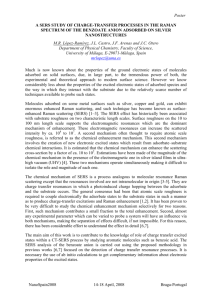
![[1] M. Fleischmann, P.J. Hendra, A.J. McQuillan, Chem. Phy. Lett. 26](http://s3.studylib.net/store/data/005884231_1-c0a3447ecba2eee2a6ded029e33997e8-300x300.png)
